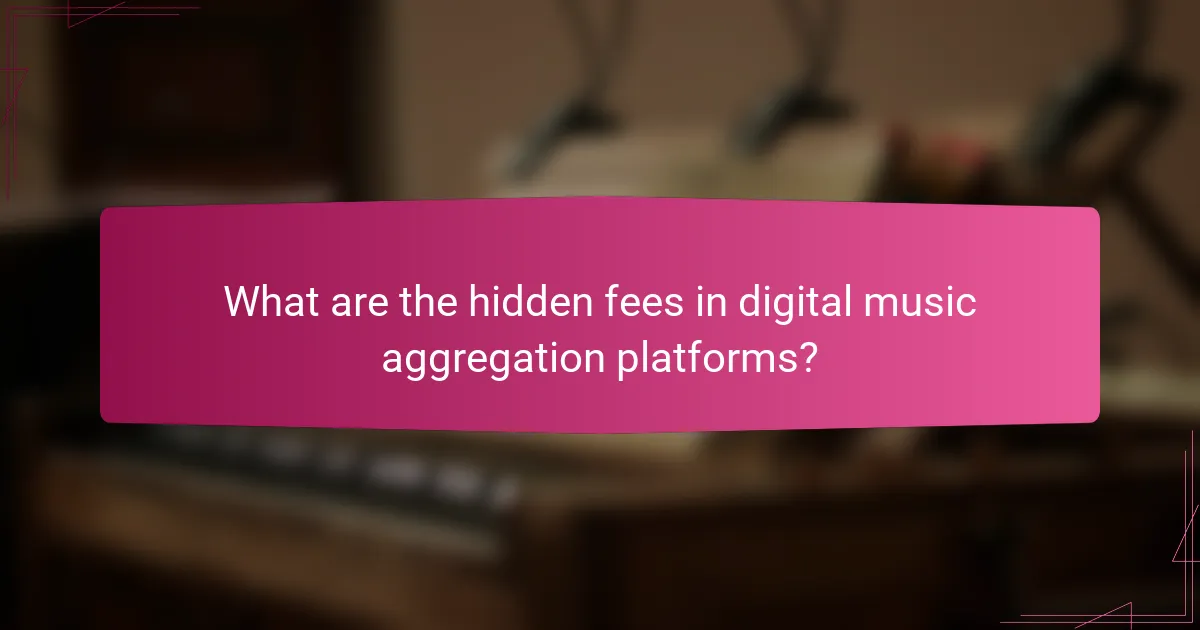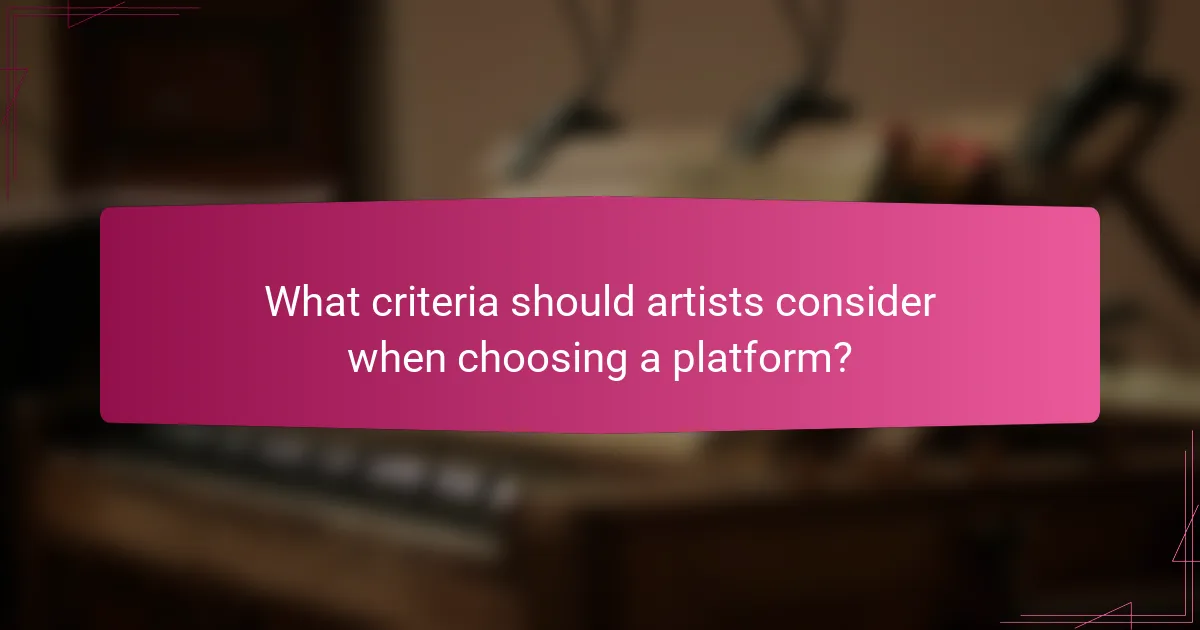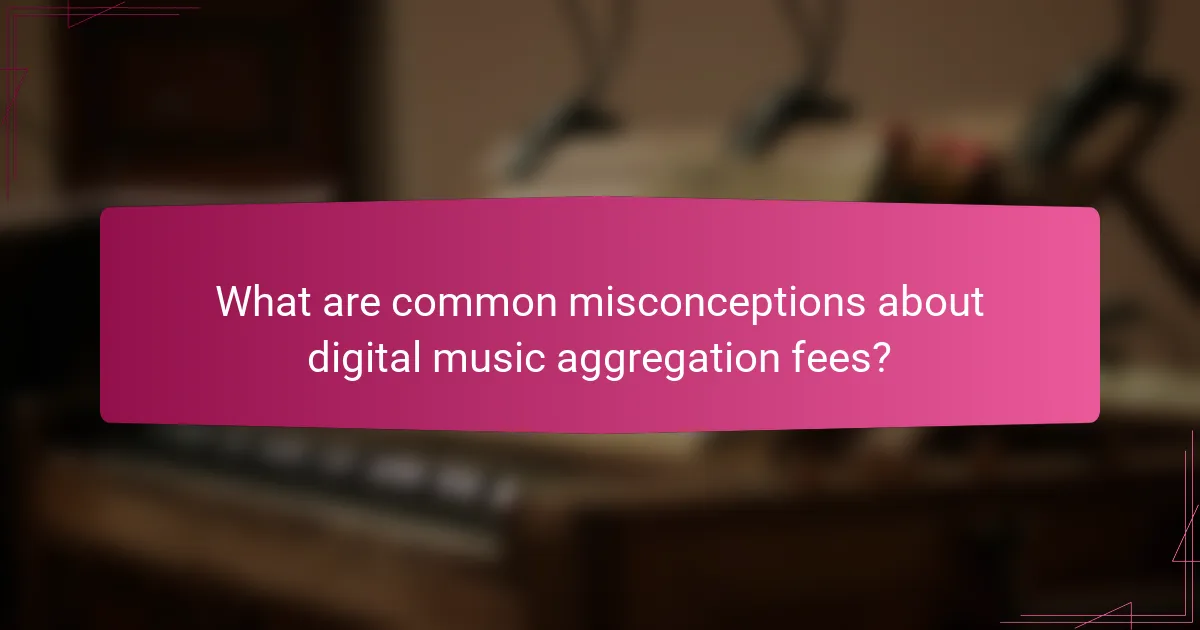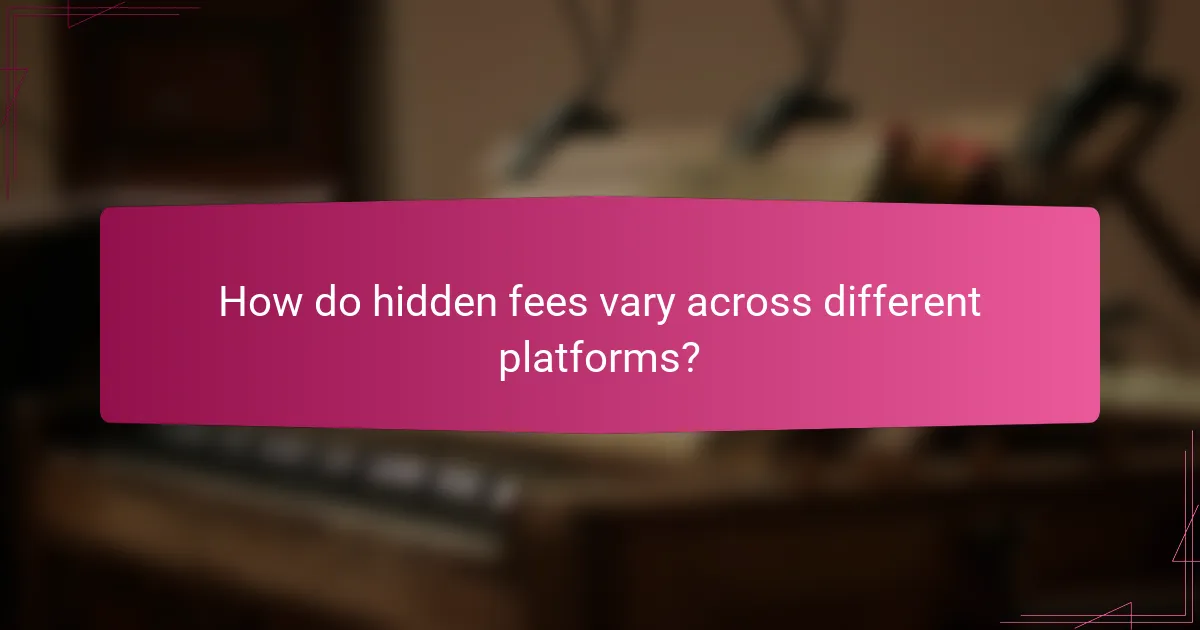Hidden fees in digital music aggregation platforms can significantly diminish artists’ earnings by introducing various undisclosed charges related to distribution and royalties. These unexpected costs often go unnoticed until payout time, resulting in financial shortfalls for musicians. To mitigate these issues, artists are encouraged to conduct thorough research, scrutinize agreements, and select transparent services that prioritize clear communication about fees.

What are the hidden fees in digital music aggregation platforms?
Hidden fees in digital music aggregation platforms refer to various charges that can significantly reduce an artist’s earnings without clear disclosure. These fees can include costs associated with distribution, streaming royalties deductions, and account maintenance, impacting overall revenue from music sales and streams.
Distribution fees
Distribution fees are charges that platforms impose for delivering music to various streaming services and digital stores. These fees can vary widely, often ranging from a flat fee per release to a percentage of sales, and may include additional costs for promotional services.
Artists should carefully review the fee structure of any aggregation service before signing up. Some platforms may offer free distribution but take a higher percentage of royalties, while others may charge upfront fees but provide better overall revenue shares.
Streaming royalties deductions
Streaming royalties deductions occur when platforms take a portion of the earnings generated from streams. This can include fees for licensing, distribution, and even promotional services that are not always clearly outlined in contracts.
Typically, these deductions can range from 10% to 30% of the total royalties earned. Artists should seek platforms that provide transparent reporting on how royalties are calculated and what deductions are applied to avoid unexpected losses.
Account maintenance charges
Account maintenance charges are fees that some digital music platforms impose for keeping an artist’s account active. These can be monthly or annual fees and may apply if certain sales thresholds are not met.
Artists should be aware of these potential charges and consider whether the benefits of the platform outweigh the costs. It’s advisable to choose platforms with minimal or no maintenance fees, especially for independent artists who may not have consistent revenue streams.

How do hidden fees impact artists in the US?
Hidden fees can significantly reduce the earnings of artists in the US, affecting their overall income from music distribution. These fees often go unnoticed until artists receive their payouts, leading to unexpected financial shortfalls.
Reduced earnings
Hidden fees can take various forms, such as distribution fees, processing charges, or even marketing costs that are not clearly disclosed. For instance, an aggregator might charge a percentage of royalties that artists were not aware of, which can lead to a decrease in their overall earnings from streaming platforms.
Artists may find that what they receive from platforms like Spotify or Apple Music is considerably less than expected due to these undisclosed costs. It’s crucial for artists to review their contracts carefully and understand all potential fees before signing up with a digital music aggregator.
Budgeting challenges
When hidden fees reduce earnings, artists face difficulties in budgeting for their music careers. This unpredictability can hinder their ability to invest in new projects, marketing, or even basic living expenses. Artists often rely on consistent income to plan tours or recording sessions, and unexpected deductions can disrupt these plans.
To mitigate these challenges, artists should maintain a detailed budget that accounts for potential fees and fluctuations in income. Regularly reviewing financial statements from aggregators can help identify discrepancies and allow for better financial planning.

What are effective strategies to prevent hidden fees?
To prevent hidden fees in digital music aggregation platforms, artists should adopt proactive strategies that include thorough research, careful reading of agreements, and choosing transparent services. These steps can significantly reduce unexpected costs and improve overall financial outcomes.
Research aggregation platforms
Start by comparing different digital music aggregation platforms to understand their fee structures. Look for reviews and testimonials from other artists to gauge their experiences with hidden charges. Popular platforms may have varying costs, so consider factors like distribution fees, percentage cuts, and additional charges for services like promotional tools.
Utilize online resources and forums where musicians share insights about their experiences with specific platforms. This can help you identify which services are more transparent and which may have a history of unexpected fees.
Read user agreements carefully
Before signing up with any aggregation platform, read the user agreement thoroughly. Pay close attention to sections that outline fees, revenue splits, and any potential additional costs that may arise. Many platforms include clauses that can lead to hidden fees if not understood properly.
Look for terms like “administrative fees” or “service charges” that could apply under certain conditions. Highlight any ambiguous language and seek clarification from the service provider to ensure you fully understand your financial obligations.
Use transparent services like DistroKid
Consider using aggregation services known for their transparency, such as DistroKid. This platform offers a straightforward pricing model with no hidden fees, allowing artists to keep 100% of their earnings. DistroKid’s flat annual fee covers unlimited uploads, making it a cost-effective choice for many musicians.
When evaluating services, check if they provide clear breakdowns of costs and earnings. Transparent platforms often have user-friendly dashboards that display real-time earnings, making it easier to track your revenue without surprises.

What criteria should artists consider when choosing a platform?
Artists should prioritize fee transparency, royalty rates, and customer support quality when selecting a digital music aggregation platform. These factors significantly impact their earnings and overall experience in distributing their music.
Fee transparency
Fee transparency refers to how clearly a platform communicates its costs to artists. A good platform should provide a detailed breakdown of all fees, including distribution, processing, and any hidden charges that may arise.
Artists should look for platforms that openly disclose their fee structures. This can include a list of all potential charges and how they affect the artist’s earnings. Avoid platforms that obscure their fees, as this can lead to unexpected deductions from royalties.
Royalty rates
Royalty rates determine how much artists earn from their music sales and streams. Different platforms offer varying rates, often ranging from 70% to 90% of the revenue generated.
When comparing platforms, artists should evaluate the royalty percentages offered and any conditions that might affect these rates. For instance, some platforms may offer higher rates but charge additional fees, which could offset the benefits. Understanding the net earnings after all deductions is crucial.
Customer support quality
Customer support quality is essential for artists who may encounter issues with their music distribution. A responsive and knowledgeable support team can help resolve problems quickly and effectively.
Artists should assess the support options available, such as live chat, email, or phone support, and the average response times. Platforms with robust customer service are often more reliable, ensuring that artists can get assistance when needed, which can be particularly important during critical release periods.

What are common misconceptions about digital music aggregation fees?
Many artists believe that all digital music aggregation platforms operate under the same fee structures, leading to confusion and potential financial loss. Understanding the nuances of these fees is crucial for maximizing earnings and avoiding unexpected costs.
All platforms charge the same fees
This misconception can lead artists to overlook the unique pricing models of different platforms. While some aggregators may charge a flat fee per release, others might take a percentage of royalties or impose annual fees. It’s essential to compare platforms to find the best fit for your needs.
For example, some platforms may charge around 10-20% of your earnings, while others might have a one-time fee of approximately $30-$50 per release. Researching these differences can help you choose a service that aligns with your financial goals.
Fees are always disclosed upfront
Not all fees associated with digital music aggregation are clearly stated at the beginning. Some platforms may have hidden costs, such as additional fees for distribution to specific stores or promotional services. Always read the fine print and inquire about any potential extra charges.
To avoid surprises, ask for a detailed breakdown of all costs before signing up. This may include transaction fees, payment processing fees, and costs for optional services. Being proactive can save you from unexpected deductions from your earnings later on.

How do hidden fees vary across different platforms?
Hidden fees in digital music aggregation platforms can differ significantly based on the service provider. These fees may include charges for distribution, licensing, and additional services, impacting the overall revenue artists receive from their music.
Types of hidden fees
Hidden fees can take various forms, including distribution fees, annual fees, and percentage cuts from royalties. Some platforms may charge for additional services like promotional tools or analytics, which can add to the overall cost. Understanding these fees is crucial for artists to assess their net earnings accurately.
Impact on artists
The presence of hidden fees can substantially reduce the income that artists receive from their music. For example, a platform that takes a 15% cut of royalties, in addition to a $20 annual fee, can significantly diminish an artist’s earnings, especially for those with lower sales volumes. Artists must evaluate these costs against potential revenue to make informed decisions.
How to prevent hidden fees
To avoid unexpected costs, artists should carefully read the terms and conditions of any digital music aggregation platform before signing up. Comparing multiple platforms is essential to identify those with transparent pricing structures. Additionally, seeking recommendations from other artists can provide insights into which platforms are the most cost-effective.
